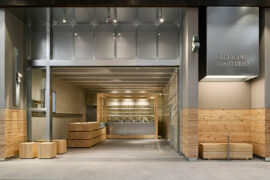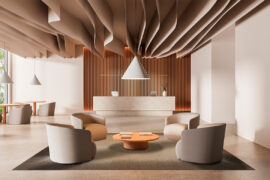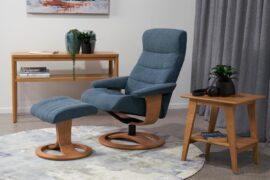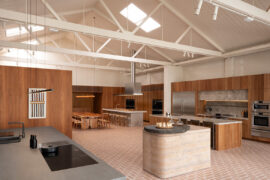Retail is the perfect typology for the creation of new experiences. Howard Sullivan, co-founder of YourStudio, shares his insights and some of the practice’s latest projects that are flipping retail on its head.
Experience design is something that gets bandied about all the time. But as typologies continue to meld and new types of spaces, and designs for those spaces keep emerging, the experience is becoming increasingly important – particularly in retail.
We ask Howard Sullivan, co-founder of London-based YourStudio, (which also has a Melbourne office) about what experience design means in this new economy.
Howard Sullivan: Humans connect through sharing and making memories together. Retail has been traditionally transactionally focused but in recent years, experience has become a more vital and pivotal ingredient. By creating moments within the shopping space, we are able to forge deep emotional connections that increase loyalty, dwell time and that overall feel-good factor.
Just like friends who we enjoy spending time with, the retailers who give us stimulation, empathy, and a sense of discovery, are those we chose over those who retain a traditionally stand-offish and un-experiential stance.
An example is with Topshop Splash!, the brand came to us and asked ‘How can we launch swimwear this year in a really innovative way?’ and we conceptualised putting a waterslide through multiple floors of the store. It was a fully immersive experience that affected all the human senses, and because it was new and exciting, customers all wanted to experience it together.
YourStudio x Topshop – Splash! VR Experience from YourStudio on Vimeo.
Retail and hospitality have become much closer in recent years. This move is in both directions with hotels like the Ace Hotel mixing DJ-ing, live events, workspace, shopping and art events within their hotel lobbies so they become active social hubs, always buzzing with energy.
If you look at retailers like Goodhood in London, they are mixing everything ‘lifestyle’ under one roof, always stimulated with events, publications and content that is really nourishing. We call it ‘one journey retail’ but it’s the idea that ‘retail’ or ‘shopping’ doesn’t need a distinct category, or time carved out for it in isolation but more needs to be seen as something we thread into our day-to-day. Whether it’s purchasing spontaneously from an influence we’ve had on Instagram or wanting to stop for a coffee while we’re out. All should be and could be offered by retailers whose brand essence aligns with our own lifestyle.
In our Virgin Holidays project, we flipped the customer journey around. When customers arrive in first class on an aeroplane they are offered champagne in their seats. So we took that experience and put it in a travel agency retail setting. Instead of the team asking customers ‘Where do you want to go on holiday this year?’, they ask if they would like a glass of champagne and sit in a first class seat before even discussing a holiday. It changes the whole experience from what customers expect to a store experience they like and want to spend time in.
The traditional route of retail by default was from bricks-and-mortar to online, but we’ve moved way beyond that point now. The split between ‘online’ and ‘offline’ is not and should not be distinct, and nowadays we’re seeing very successful online businesses taking their expertise and products into physical space.
Birchbox is brand that is a great example of this. It is one of the USA’s biggest beauty subscription services, selling beauty and personal care as a mostly subscription package. Hugely successful online and you wouldn’t necessarily think it would need to translate the offer into a physical space. However, we worked with them on this transition, creating its first flagship in London. What has been so powerful is seeing the level of engagement in the physical space and how this drives loyalty online.
Like an ecosystem, I strongly believe the two opportunities of offline and online retail are intrinsically linked. After all, as human beings, nothing beats face-to-face service in a real space. Having said that, when you need convenience, if you can purchase at the click of a button, that’s equally powerful. Ultimately, understanding what people need where and how to deliver to those needs is key in informing how design can enhance and shape the experience, whether it’s in the digital or physical world.
This is such a broad question it’s quite hard to answer. We all have a million things going on in our heads, we are in different states of mind day-to-day and minute-to-minute, different things may appeal to people at different times. Ultimately, our work is all about human emotion – connection, happiness, joy, inspiration.
If you can achieve a deep emotional connection with a person through an experience you have created, then the rewards are for everyone. We always aim for our experiences to connect in three ways to attempt to be deeper than the purely momentary or superficial. These are physical (space, materials, look and feel), cognitive (what are you learning, how is your mind stimulated) and sensory (tapping into your deep subconscious).
The ultimate resonance of an experience is how much it stands out in someone’s mind and how likely they are to share their story of it or recommend it to a friend.
As with any form of evolution, we are in a constant state of flux and change, and no time is more exciting than the present. New technologies such as AR and VR, which can take people out of their every day and almost feel like magic – we can fly, we can be transported to otherworldly places – are creating experiences we might not get to taste in our everyday lives.
But technology is just a tool and only one small facet of our opportunities. If we can help people discover something about themselves and learn and grow in some kind of new direction, then we are contributing to our ability as humans to continually evolve our perspective on life and the planet.
Ultimately, as designers, we can help to make the world a better place or, at least, provide tools to help people become the best people they possibly can. Who wouldn’t love the potential of that challenge?
INDESIGN is on instagram
Follow @indesignlive
A searchable and comprehensive guide for specifying leading products and their suppliers
Keep up to date with the latest and greatest from our industry BFF's!

The undeniable thread connecting Herman Miller and Knoll’s design legacies across the decades now finds its profound physical embodiment at MillerKnoll’s new Design Yard Archives.

Merging two hotel identities in one landmark development, Hotel Indigo and Holiday Inn Little Collins capture the spirit of Melbourne through Buchan’s narrative-driven design – elevated by GROHE’s signature craftsmanship.

London-based design duo Raw Edges have joined forces with Established & Sons and Tongue & Groove to introduce Wall to Wall – a hand-stained, “living collection” that transforms parquet flooring into a canvas of colour, pattern, and possibility.

Hecker Guthrie brings a natural, material-led design to Green Cup’s new Chadstone store, pairing pine, steel and glass with a grab-and-go layout inspired by the brand’s fresh, organic ethos.

Tom Mark Henry refines a layered design legacy into a softly sculpted retreat in Redfern, where light, tactility and crafted detail define a new expression of restrained luxury.
The internet never sleeps! Here's the stuff you might have missed

A stunning indoor space reveals artistry in every aspect, from outlook to underfoot.

Your main seating can be a stylish centrepiece, not just a functional chair.

The Fisher and Paykel Melbourne Experience Centre by Clare Cousins Architects with Fisher and Paykel Design and Alt Group has been awarded The Retail Space at the INDE.Awards 2025. As a winning project, it redefines the possibilities of retail architecture by creating an immersive, material rich environment shaped by place, culture and craft.